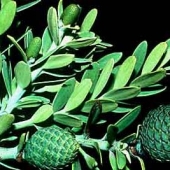Please select root levels for the menu
NZ Plants
Phyllocladus alpinus - mountain toatoa
Celery pine family: Phyllocladaceae
-
Mature foliage consists of irregularly-arranged phylloclades.
L Jensen
View picture -
Phylloclades are incised to various degrees, often forming distinct lobes
I MacDonald
View picture -
Phlloclade, upper surface. The phylloclade margin is composed of numerous shoot tips each protected by a scale
L Jensen
View picture -
Phylloclad, lower surface with numerous stomatal pores
L Jensen
View picture -
Juvenile with needle-shaped leaves and early phylloclades.
L Jensen
View picture -
Growing shoots
I MacDonald
View picture -
Branch tip with scale leaves and young phylloclade
L Jensen
View picture -
Young, growing phylloclades each subtened by a scale
L Jensen
View picture -
Older, lobbed phylloclade
L Jensen
View picture -
Pollen cones
L Jensen
View picture -
Pollen cone
L Jensen
View picture -
Pollen cone scales
L Jensen
View picture -
Ovule cone. Ovules are borne on fleshy scales.
L Jensen
View picture -
Protruding from each ovule is a tubular-like pore (purple) that allows pollen grains to reach the ovule to the inside.
L Jensen
View picture -
After pollination the ovules and the fleshy scales enlarge and change colour.
L Jensen
View picture -
Ripening seed with developing aril (white collar)
L Jensen
View picture -
Mature cone, fleshy bracts subtending a seed with a collar-like white aril
L Jensen
View picture
Phyllocladus alpinus is a many-branched shrub or small tree. Seedling plants have narrow, flattened needle-like leaves. Adult plants have flattened photosynthetic leaf-like stems (phylloclades). The thick phylloclades are undivided, usually have a waxy grey-blue covering and margins are toothed to lobed. Minute scale-like leaves are formed on segment margins. Small, fleshy ovule cones are formed.
An endemic species found at higher elevations from the central North Island to lower elevations on the South Island.
Phyllocladus is a small genus with three endemic species, one species in Tasmania and one species found from New Guinea to Borneo & the Philippines. It is sometimes placed in the Podocarpaceae.
Vegetative characteristics |
Reproductive characteristics |
|---|---|
Adult plant form: tree up to 10 m |
Pollen and ovule cones: on the same or separate trees |
Phylloclade form: undivided, of variable shape |
Pollen cone: 4-6 mm long |
Phylloclade size: 5-25 mm long x 3-12 mm wide |
Ovule cone: small, globular, 1-5 fertile cone scales and sterile bracts |
Phylloclade arrangement: singly along stem to almost opposite one another |
Ovule cone position: lateral on stems of phylloclades, or at phylloclade margins |
Phylloclade margin: toothed to lobed |
Ovule coverings: a single covering (integument) |
Adult leaves (denticles): scale-like, 0.5-2 mm, on margin of phylloclade |
Ovule pore (micropyle): directed upward |
Juvenile leaves: singly on stem, narrow-linear (needle-like) up to 15 mm , deciduous |
Mature seed cone: each seed develops a white aril at the base, enclosed by enlarged sterile bracts, that turn reddish or purplish |
Stem(receptacle) below seed: stalk not fleshy |




